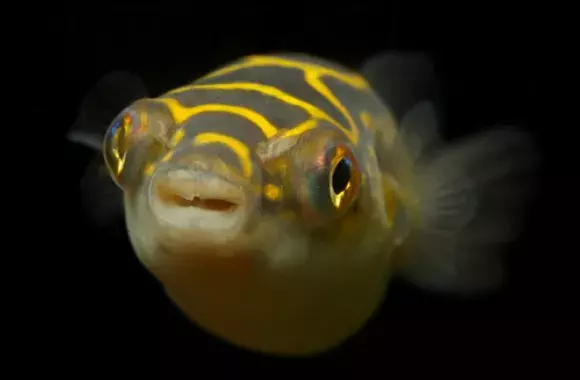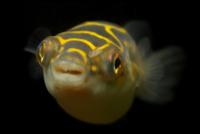
Quick Care Details (Table)
| Livestock Characteristics | Value |
|---|---|
| Care Level | Moderate |
| Temperament | Aggressive |
| Diet | Carnivore |
| Maximum Size | 3 Inches |
| Minimum Tank Size | 30 Gallons |
| Plant Safe | Yes |
| Temperature Range | 75-82F |
| PH Range | 7.0-8.0 |
| KH Range | 8-15 |
Species Specific Categories
Helpful Video
Care Details
- Aquascape: Create a natural-looking environment with plenty of hiding spots using plants, rocks, and driftwood to mimic their natural habitat.
- Substrate: Choose a soft substrate like sand or smooth gravel to prevent injury to their delicate undersides.
- Disease Prevention: Maintain excellent water quality through regular water changes and monitor for signs of common freshwater fish diseases. Quarantine new fish before introducing them to the main tank to prevent the spread of diseases.
- Filtration: Use a high-quality filtration system to keep the water clean and free from toxins. Consider a combination of mechanical, biological, and chemical filtration to ensure optimal water quality.
- Lighting: Provide moderate lighting to simulate natural daylight conditions. Avoid intense lighting, as Figure 8 Puffers prefer dimly lit environments.
- Water Flow: Maintain gentle water flow to mimic their natural habitat. Avoid strong currents that may stress the fish.
- Hardiness: Figure 8 Puffers are relatively hardy fish when kept in suitable conditions with stable water parameters.
- Acclimation: When introducing Figure 8 Puffers to a new tank, acclimate them slowly to prevent stress and shock. Gradually adjust the water parameters over a period of time before releasing them into the main tank.
- Expected Lifespan: With proper care, Figure 8 Puffers can live up to 5 years or more in captivity.
- Special Requirements: Monitor their teeth growth, as they may need hard foods or snails to wear them down naturally. Provide a varied diet to ensure they receive essential nutrients. Keep tank mates compatible with their peaceful temperament to prevent aggression and stress.
Temperament and Behavior
- Behavior: Figure 8 Puffers are generally peaceful and curious fish, known for their intelligent behavior and playful nature. They often explore their surroundings and interact with objects in the tank.
- Breeding: Breeding Figure 8 Puffers in captivity is challenging and rarely done in home aquariums. Little is known about their breeding habits in the wild, and successful breeding attempts in captivity are few and far between.
- Aggression: While Figure 8 Puffers are typically peaceful, they can become aggressive towards conspecifics (other Figure 8 Puffers) or other tank mates if they feel threatened or stressed. Avoid keeping them with aggressive or territorial fish that may intimidate or harm them.
- Tankmates Compatibility: Choose tank mates that are compatible with the peaceful temperament of Figure 8 Puffers. Avoid aggressive or territorial fish and opt for peaceful community fish or species that inhabit different areas of the tank.
- Activity Level: Figure 8 Puffers are moderately active fish, spending much of their time exploring their environment and searching for food. They appreciate a tank with plenty of hiding spots and areas to explore.
- Schooling or Shoaling Behavior: Figure 8 Puffers do not exhibit schooling or shoaling behavior and are generally solitary fish. They may tolerate conspecifics in larger tanks with plenty of hiding spots, but aggression can occur, especially during mating.
- Plant Compatibility: Figure 8 Puffers may nip at or uproot plants in the aquarium, especially if they are not provided with enough hard surfaces to wear down their teeth. Choose hardy plants like Java fern, Anubias, or floating plants that can withstand their activity.
Diet and Nutrition
- Dry Foods: Offer high-quality dry foods specifically formulated for puffers, such as pellets or flakes. Ensure the food is appropriately sized for the fish to consume easily.
- Frozen Foods: Supplement their diet with frozen foods like bloodworms, brine shrimp, and daphnia. Thaw the frozen foods before feeding to prevent digestive issues.
- Live Foods: Provide occasional live foods such as snails, small shrimp, or insect larvae to mimic their natural diet and stimulate hunting behavior. Ensure the live foods are from a reputable source to prevent introducing parasites or diseases to the tank.
- Vegetables: While Figure 8 Puffers are primarily carnivorous, they may nibble on blanched vegetables like zucchini or cucumber as a source of fiber and nutrients. Offer vegetables sparingly as a supplemental part of their diet.
- Algae: Figure 8 Puffers may graze on algae growing in the tank, but it should not be their primary source of nutrition. Ensure they receive a varied diet to meet their nutritional needs.
- Feeding Schedule: Feed Figure 8 Puffers small amounts of food 2-3 times a day, adjusting the feeding schedule based on their activity level and appetite. Avoid overfeeding to prevent obesity and water quality issues.
- Supplemental Foods: Consider supplementing their diet with calcium-rich foods like snail shells or cuttlebone to support their dental health and prevent overgrowth of their teeth. Additionally, vitamin supplements can be added to their diet occasionally to ensure they receive essential nutrients.
Tank Parameters
- Tank size: Provide a minimum tank size of 20 gallons for a single Figure 8 Puffer, with additional space for each additional fish to accommodate their territorial behavior.
- Tank Length and Measurements: Choose a tank with dimensions that allow for adequate swimming space and provide plenty of hiding spots and areas for exploration.
- Water Temperature: Maintain a water temperature in the range of 75-80°F (24-27°C) to ensure the comfort and well-being of Figure 8 Puffers.
- pH (Acidity/Alkalinity): Aim for a pH level between 7.0 and 8.0 to maintain stable water conditions and support healthy fish.
- KH (Carbonate Hardness): Carbonate hardness helps buffer pH fluctuations in the water. Aim for a KH level between 5-15 dKH (90-270 ppm) to maintain stable water parameters.
- GH (General Hardness): General hardness refers to the concentration of dissolved minerals in the water, particularly calcium and magnesium. Aim for a GH level between 5-15 dGH (90-270 ppm) to ensure optimal health and growth.
- Hardiness: Figure 8 Puffers are relatively hardy fish when kept in suitable conditions with stable water parameters. However, sudden fluctuations in water parameters can stress them and lead to health issues.
- Nitrate (NO3) levels: Monitor nitrate levels in the aquarium and keep them below 20 ppm through regular water changes and maintenance. High nitrate levels can negatively impact fish health and water quality.
History, Popularity, History and Species Variety Details
The History, Popularity and Natural Habitat
The History:
The Figure 8 Puffer, scientifically known as Tetraodon biocellatus, has a history deeply rooted in the natural landscapes of Southeast Asia. Its presence in the aquarium trade began to gain momentum as enthusiasts sought out unique and visually striking freshwater fish species. Initially, it was primarily found in local fish markets across its native range, but as interest grew globally, it became increasingly accessible to aquarists worldwide. This fish has transitioned from being a novelty in the aquarium trade to a beloved staple, captivating hobbyists with its charming personality and distinctive markings.
Popularity:
The Figure 8 Puffer has garnered considerable popularity among aquarium enthusiasts due to its captivating appearance and engaging behavior. Its striking figure-eight pattern and curious demeanor make it a standout addition to freshwater aquariums. As aquarists seek out unique and charismatic species to populate their tanks, the Figure 8 Puffer has emerged as a favorite choice. Its popularity continues to grow as more hobbyists discover and appreciate its endearing qualities, contributing to its status as a sought-after species in the aquarium hobby.
Natural Habitat:
The natural habitat of the Figure 8 Puffer encompasses freshwater environments in Southeast Asia, particularly in countries like Thailand, Malaysia, and Indonesia. Within its native range, this species inhabits slow-moving or still waters, including rivers, streams, and ponds. These habitats are characterized by lush vegetation, abundant hiding spots such as plants and driftwood, and a variety of small invertebrates and crustaceans, which form a significant part of the puffer's diet. Adaptable to varying water conditions, the Figure 8 Puffer thrives in warm, tropical climates and is often found in shallow waters with sandy or muddy substrates.
Similar and Variations of the Species:
- Green Spotted Puffer (Tetraodon nigroviridis)
- Mbu Puffer (Tetraodon mbu)
- Congo Puffer (Tetraodon miurus)
- Fahaka Puffer (Tetraodon lineatus)
Personal Perspective
These charming little fish have become the heart and soul of my underwater world, each with its unique personality quirks that never fail to entertain me. As I watch them playfully darting around their tank, I can't help but reminisce about the time when one of them, affectionately named Finn, decided to redecorate the tank by rearranging the plants to his liking. It was a comical sight, watching him diligently move each piece until he was satisfied with his masterpiece. Since then, every time I look at my aquarium, I'm reminded of the joy and wonder these remarkable creatures bring into my life, making every moment spent with them truly unforgettable.
Frequently Asked Questions
Can Figure 8 Puffers live in a community tank with other fish?
While Figure 8 Puffers can coexist with certain tank mates, it's crucial to choose species that are compatible with their peaceful temperament and won't outcompete them for food or territory. Avoid aggressive or territorial fish that may intimidate or harm them.
Can Figure 8 Puffers be kept in a planted tank?
Yes, but it's essential to choose hardy plants like Java fern, Anubias, or floating plants that can withstand their activity. Additionally, provide plenty of hiding spots and areas to explore to mimic their natural habitat.
Are Figure 8 Puffers prone to any specific diseases?
Figure 8 Puffers are relatively hardy fish, but they can be susceptible to common freshwater fish diseases like Ich (white spot disease) and bacterial infections. Maintaining excellent water quality and quarantining new fish before introducing them to the main tank can help prevent the spread of diseases.
How big of a tank do Figure 8 Puffers need?
Provide a minimum tank size of 20 gallons for a single Figure 8 Puffer, with additional space for each additional fish to accommodate their territorial behavior and ensure they have enough room to swim and explore.
Can Figure 8 Puffers eat algae in the tank?
While Figure 8 Puffers may graze on algae, it should not be their primary source of nutrition. It's essential to provide a varied diet consisting of high-quality prepared foods, frozen foods, and occasional live foods to meet their nutritional needs adequately.


